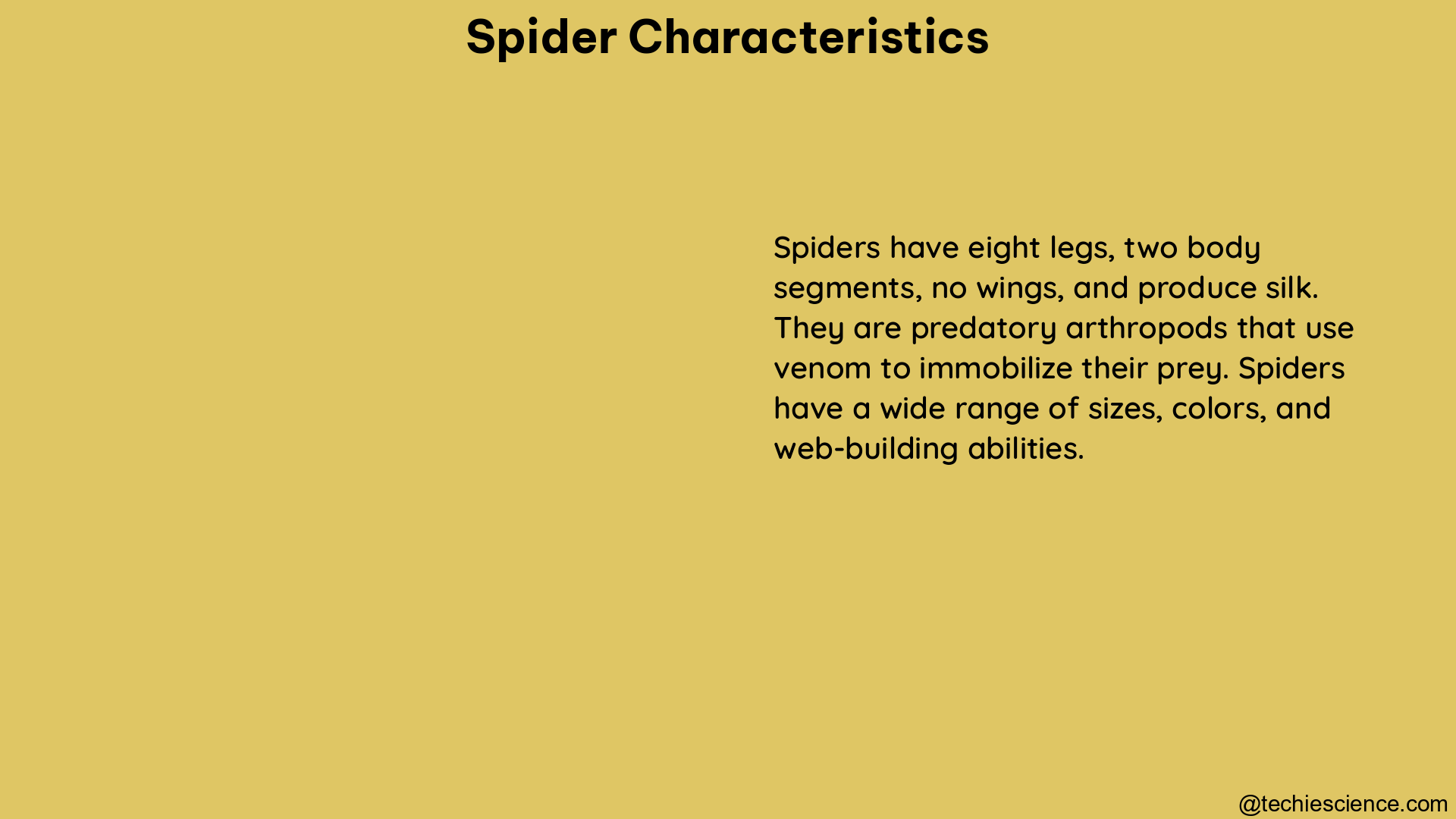Spiders are a diverse group of arthropods that have captivated the interest of scientists and nature enthusiasts alike. Their unique characteristics, ranging from their intricate morphology to their complex behavioral patterns, have been the subject of extensive research and study. In this comprehensive guide, we will delve into the various aspects of spider characteristics, providing a detailed exploration of their morphological, ecological, physiological, and behavioral traits.
Morphological Characteristics of Spiders
Spiders are known for their distinctive body structure, which is divided into two main parts: the cephalothorax (or prosoma) and the abdomen (or opisthosoma). These morphological traits are crucial in understanding the diversity and adaptations of different spider species.
Total Body Size
The total body size of spiders can vary significantly, ranging from a few millimeters to over 10 centimeters. The largest known spider species is the Goliath birdeater (Theraphosa blondi), which can have a leg span of up to 30 centimeters and a body length of up to 12 centimeters. In contrast, the smallest known spider species is the Patu digua, which measures just 0.37 millimeters in body length.
Prosoma Dimensions
The prosoma, or cephalothorax, is the anterior part of the spider’s body and houses the vital organs, including the brain, eyes, and mouthparts. The dimensions of the prosoma, including length, width, and height, can vary significantly among different spider species. For example, the prosoma length of the common house spider (Parasteatoda tepidariorum) ranges from 2.5 to 4.5 millimeters, while the prosoma length of the giant huntsman spider (Heteropoda maxima) can reach up to 6 centimeters.
Leg Dimensions
The legs of spiders are another important morphological characteristic, with the length of the first tibia (Tibia I) being a commonly measured trait. The tibia I length can range from a few millimeters in smaller species to over 10 centimeters in larger species, such as the giant huntsman spider.
Fang Length
The fangs, or chelicerae, of spiders are used for prey capture and defense. The length of the fangs can vary significantly among different spider species, with some species having relatively short fangs while others, such as the Brazilian wandering spider (Phoneutria fera), can have fangs up to 2 centimeters long.
Ecological Characteristics of Spiders

Spiders exhibit a wide range of ecological traits that allow them to thrive in diverse habitats and fulfill various roles within their ecosystems.
Dispersal Ability
Spiders have developed various mechanisms for dispersal, including ballooning (using silk threads to ride air currents) and active walking or crawling. The dispersal ability of spiders can range from low, where individuals rarely move more than a few meters, to high, where they can travel hundreds of kilometers.
Vertical Stratification
Spiders can be found occupying different vertical strata within their habitats, from the ground level to the canopy of forests. This vertical stratification is influenced by factors such as prey availability, microclimate, and predation risk.
Circadian Activity
Spiders exhibit a range of circadian activity patterns, with some species being primarily diurnal (active during the day), others being nocturnal (active at night), and some being crepuscular (active at dawn and dusk).
Foraging Strategy
Spiders have evolved a variety of foraging strategies, including ambush predation, active hunting, and web-building. These strategies are often closely linked to the spider’s morphology, habitat, and prey preferences.
Trophic Specialization
Spiders can be classified based on their trophic specialization, which refers to the types of prey they consume. Some spider species are generalists, feeding on a wide range of prey, while others are specialists, targeting specific prey types.
Colonization Status
Some spider species are endemic, meaning they are native to a specific geographic region, while others are invasive, having been introduced to new areas and successfully colonizing them.
Physiological Characteristics of Spiders
Spiders possess a range of physiological adaptations that allow them to thrive in their respective environments.
Respiratory System
Spiders have a unique respiratory system known as book lungs, which are specialized respiratory organs that allow them to efficiently exchange gases. The number and structure of book lungs can vary among different spider species.
Circulatory System
Spiders have an open circulatory system, where the blood (or hemolymph) is not contained within a closed system of blood vessels. Instead, it circulates through the body cavity and is pumped by a dorsal heart.
Excretory System
Spiders have an excretory system that includes Malpighian tubules, which are responsible for the removal of metabolic waste products from the hemolymph. The structure and function of the excretory system can vary among different spider species.
Behavioral Characteristics of Spiders
Spiders exhibit a wide range of complex behaviors, from web-building to courtship and prey capture.
Web-building Behavior
Spiders are renowned for their ability to construct intricate web structures, which they use for prey capture, shelter, and communication. Different spider species build a variety of web types, including orb-webs, funnel-webs, and sheet-webs.
Courtship and Mating Behavior
Spiders have evolved diverse courtship and mating behaviors, which can involve complex visual, vibratory, and chemical signals. These behaviors can vary significantly among different spider species, with some species engaging in elaborate courtship rituals while others have more simple mating strategies.
Prey Capture Behavior
Spiders have developed a range of prey capture strategies, including ambush predation, active hunting, and the use of specialized web structures. The specific prey capture behaviors of spiders are often closely linked to their morphological and ecological characteristics.
By exploring the various aspects of spider characteristics, we can gain a deeper understanding of the remarkable diversity and adaptations of these fascinating arachnids. This comprehensive guide provides a valuable resource for biologists, naturalists, and anyone interested in the fascinating world of spiders.
References:
- Cardoso, P., Mammola, S., Rigal, F., & Carvalho, J. C. (2020). Functional traits of spiders (Araneae) – A review of their use in ecological and taxonomic studies. Perspectives in Ecology and Conservation, 18(4), 237-258. https://doi.org/10.1016/j.pecon.2020.09.003
- Foelix, R. F. (2011). Biology of Spiders (3rd ed.). Oxford University Press.
- Harmer, A. M., Blackledge, T. A., Madin, J. S., & Herberstein, M. E. (2011). High-performance spider webs: integrating biomechanics, ecology, and behaviour. The Journal of the Royal Society Interface, 8(57), 457-471. https://doi.org/10.1098/rsif.2010.0454
- Nentwig, W., Blick, T., Gloor, D., Hänggi, A., & Kropf, C. (2022). Spiders of Europe. https://www.araneae.nmbe.ch/
- Pekár, S., & Toft, S. (2015). Trophic specialisation in a predatory group: the case of prey-specialised spiders (Araneae). Biological Reviews, 90(3), 744-761. https://doi.org/10.1111/brv.12133

Hi, I am Saif Ali. I obtained my Master’s degree in Microbiology and have one year of research experience in water microbiology from National Institute of Hydrology, Roorkee. Antibiotic resistant microorganisms and soil bacteria, particularly PGPR, are my areas of interest and expertise. Currently, I’m focused on developing antibiotic alternatives. I’m always trying to discover new things from my surroundings. My goal is to provide readers with easy-to-understand microbiology articles.
If you have a bug, treat it with caution and avoid using antibiotics to combat SUPERBUGS.
Let’s connect via LinkedIn: